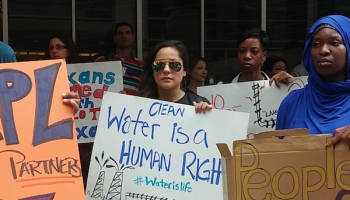When school drinking water is sampled and analyzed, it is not uncommon for schools to find lead in many different water sources. This happens because, even today, plumbing materials may contain lead that leaches into the drinking water for students and school faculty and staff members. This is exacerbated when water use is cut back and becomes stagnant in the plumbing during weekends and seasonal breaks and reduces the effectiveness of the corrosion control chemicals that are added to water to prevent contamination.
Sampling and testing drinking water in schools is costly. Currently, there are no enforceable federal mandates for testing drinking water in schools or remediating lead hazards. Furthermore, testing merely confirms the presence of a source of lead exposure in the water system without actually addressing the problem. Replacing supply fixtures where lead contamination is found doesn’t actually guarantee a lead-free source of water because the plumbing system likely still contains lead. In addition, replacing all the plumbing in a school is incredibly expensive and some new plumbing materials can still pose an ongoing risk of lead exposure.
So, how can schools provide a safe, lead-free source of water? Some school districts in Michigan have started to phase in filtered drinking water stations. These filtered water stations are drinking water fountains and bottle filling stations with certified filters that reduce aesthetic impurities (i.e. chlorine and odors) and remove dangerous lead particulates. These systems can replace old drinking fountains, be retrofitted for existing fountains, or be installed independently
The filtered hydration station units can cost anywhere from $600 to $3,000, with installation, ancillary, and removal fees ranging from hundreds to thousands of dollars, depending on the project. After installation, schools also need a budget for maintenance costs, including replacement filters. Filters cost around $100 each and need to be replaced every year or as soon as the 3,000-gallon capacity is reached.
To ensure adequate access to clean, lead-free water, schools should install 1 unit per every 100 students enrolled. Successfully implementing filtered water stations in a school requires ongoing support and maintenance, appropriate signage, culture and habit modification, verification, sampling, timely transparency and communication, and funding.
Filtered hydration stations will be used to filter out lead in school water for students, faculty, and staff in Flint, Detroit, Royal Oak, Ann Arbor, Dearborn, and Birmingham public schools.
In 2018, Detroit Public Schools voluntarily tested its drinking water and found elevated lead levels in 57 schools. Superintendent Nikolai Vitti then announced that the school would be installing 818 hydration stations across 106 schools. Detroit is one of the largest districts to adopt this technology. The district raised the nearly $3 million needed for the project through community and private donors. Students will get their own reusable water bottles in order to take full advantage of the stations. Principals and school engineers are being trained to monitor systems and replace filters as needed.
Michigan needs to act now in order to guarantee all students and staff have access to a reliable source of clean, safe drinking water at school. Michigan needs to support Governor Whitmer’s budget proposal allocating $60 million to the installation of filtered drinking water stations in all schools. The state legislature needs to pass the supplemental budget and require filtered drinking water stations to be installed in all Michigan public schools. Additional funds should also be provided to schools for the ongoing costs of maintenance and testing for lead and copper following installation.


